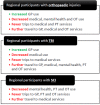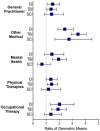Serious Injury in Metropolitan and Regional Victoria: Exploring Travel to Treatment and Utilisation of Post-Discharge Health Services by Injury Type
- PMID: 36360940
- PMCID: PMC9657338
- DOI: 10.3390/ijerph192114063
Serious Injury in Metropolitan and Regional Victoria: Exploring Travel to Treatment and Utilisation of Post-Discharge Health Services by Injury Type
Abstract
This study aimed to describe regional variations in service use and distance travelled to post-discharge health services in the first three years following hospital discharge for people with transport-related orthopaedic, brain, and spinal cord injuries. Using linked data from the Victorian State Trauma Registry (VSTR) and Transport Accident Commission (TAC), we identified 1597 people who had sustained transport-related orthopaedic, brain, or spinal cord injuries between 2006 and 2016 that met the study inclusion criteria. The adjusted odds of GP service use for regional participants were 76% higher than for metropolitan participants in the orthopaedic and traumatic brain injury (TBI) groups. People with spinal cord injury (SCI) living in regional areas had 72% lower adjusted odds of accessing mental health, 76% lower adjusted odds of accessing OT services, and 82% lower adjusted odds of accessing physical therapies compared with people living in major cities. People with a TBI living in regional areas on average travelled significantly further to access all post-discharge health services compared with people with TBI in major cities. For visits to medical services, the median trip distance for regional participants was 76.61 km (95%CI: 16.01-132.21) for orthopaedic injuries, 104.05 km (95% CI: 51.55-182.78) for TBI, and 68.70 km (95%CI: 8.34-139.84) for SCI. Disparities in service use and distance travelled to health services exist between metropolitan Melbourne and regional Victoria following serious injury.
Keywords: access to healthcare; geography; healthcare utilisation; orthopaedic injury; road trauma; serious injury; spinal cord injury; traumatic brain injury.
Conflict of interest statement
The authors declare no conflict of interest. The funders had no role in the design of the study; in the collection, analyses, or interpretation of data; in the writing of the manuscript; or in the decision to publish the results.
Figures







Similar articles
-
Regional variation in travel to health services following transport-related major trauma.Injury. 2022 May;53(5):1707-1715. doi: 10.1016/j.injury.2021.12.011. Epub 2021 Dec 24. Injury. 2022. PMID: 34974907
-
Access to Healthcare Following Serious Injury: Perspectives of Allied Health Professionals in Urban and Regional Settings.Int J Environ Res Public Health. 2021 Jan 29;18(3):1230. doi: 10.3390/ijerph18031230. Int J Environ Res Public Health. 2021. PMID: 33573066 Free PMC article.
-
Caring for people with serious injuries in urban and regional communities: a qualitative investigation of healthcare providers' perceptions.Disabil Rehabil. 2021 Oct;43(21):3052-3060. doi: 10.1080/09638288.2020.1728787. Epub 2020 Feb 28. Disabil Rehabil. 2021. PMID: 32109168
-
Prevalence of concomitant traumatic cranio-spinal injury: a systematic review and meta-analysis.Neurosurg Rev. 2020 Feb;43(1):69-77. doi: 10.1007/s10143-018-0988-3. Epub 2018 Jun 7. Neurosurg Rev. 2020. PMID: 29882173 Free PMC article.
-
Predictors of participation and quality of life following major traumatic injuries in childhood: a systematic review.Disabil Rehabil. 2022 Jun;44(12):2591-2607. doi: 10.1080/09638288.2020.1849425. Epub 2020 Nov 24. Disabil Rehabil. 2022. PMID: 33232616
Cited by
-
Exploring the Social Determinants of Health and Health Disparities in Traumatic Brain Injury: A Scoping Review.Brain Sci. 2023 Apr 23;13(5):707. doi: 10.3390/brainsci13050707. Brain Sci. 2023. PMID: 37239178 Free PMC article.
-
Influence of Psychological Factors on Participation and Life Satisfaction in the Context of Travel and Tourism after Spinal Cord Injury.Int J Environ Res Public Health. 2022 Dec 28;20(1):516. doi: 10.3390/ijerph20010516. Int J Environ Res Public Health. 2022. PMID: 36612836 Free PMC article.
References
-
- World Health Organization . World Health Organization Global Burden of Disease. World Health Organization; Geneva, Switzerland: 2007.
-
- Gabbe B.J., Simpson P.M., Cameron P.A., Ponsford J., Lyons R.A., Collie A., Harrison J.E., Ameratunga S., Nunn A., Braaf S., et al. Long-term health status and trajectories of seriously injured patients: A population-based longitudinal study. PLoS Med. 2017;14:e1002322. doi: 10.1371/journal.pmed.1002322. - DOI - PMC - PubMed
Publication types
MeSH terms
LinkOut - more resources
Full Text Sources
Medical
Miscellaneous

